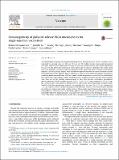| dc.contributor.author | Guarecuco, Rohiverth | |
| dc.contributor.author | Lu, Jennifer | |
| dc.contributor.author | McHugh, Kevin J | |
| dc.contributor.author | Norman, James J | |
| dc.contributor.author | Thapa, Lavanya S | |
| dc.contributor.author | Lydon, Emily | |
| dc.contributor.author | Langer, Robert | |
| dc.contributor.author | Jaklenec, Ana | |
| dc.date.accessioned | 2021-10-27T20:28:58Z | |
| dc.date.available | 2021-10-27T20:28:58Z | |
| dc.date.issued | 2018 | |
| dc.identifier.uri | https://hdl.handle.net/1721.1/135716 | |
| dc.description.abstract | © 2017 The World Health Organization's Expanded Programme on Immunization has led to a dramatic rise in worldwide vaccination rates over the past 40 years, yet 19.4 million infants remain underimmunized each year. Many of these infants have received at least one vaccine dose but may remain unprotected because they did not receive subsequent booster doses due to logistical challenges. This study aimed to develop injectable controlled release microparticles with kinetics that mimic common vaccine dosing regimens consisting of large antigen doses administered periodically over the course of months in order to eliminate the need for boosters. Sixteen poly(lactic-co-glycolic acid) (PLGA) microsphere formulations containing bovine serum albumin (BSA) as a model vaccine antigen were screened in vitro to determine their respective release kinetics. Three formulations that exhibited desirable pulsatile release profiles were then selected for studying immunogenicity in mice. Two low-dose microsphere formulations induced peak anti-BSA IgG antibody titers of 13.9 ± 1.3 and 13.7 ± 2.2 log2 compared to 15.5 ± 1.5 log2 for a series of three bolus injections delivered at 0, 4, and 8 weeks with an equivalent cumulative dose. Similarly, high-dose formulations induced peak antibody titers that were 16.1 ± 2.1 log2 compared to 17.7 ± 2.2 log2 for controls. All three microparticle formulations studied in vivo induced peak antibody titers that were statistically similar to bolus controls. These results suggest that pulsatile antigen release from polymeric microparticles is a promising approach for single-injection vaccination, which could potentially reduce the logistical burden associated with immunization in the developing world. | |
| dc.language.iso | en | |
| dc.publisher | Elsevier BV | |
| dc.relation.isversionof | 10.1016/J.VACCINE.2017.05.094 | |
| dc.rights | Creative Commons Attribution 4.0 International license | |
| dc.rights.uri | https://creativecommons.org/licenses/by/4.0/ | |
| dc.source | Elsevier | |
| dc.title | Immunogenicity of pulsatile-release PLGA microspheres for single-injection vaccination | |
| dc.type | Article | |
| dc.contributor.department | Koch Institute for Integrative Cancer Research at MIT | |
| dc.relation.journal | Vaccine | |
| dc.eprint.version | Final published version | |
| dc.type.uri | http://purl.org/eprint/type/JournalArticle | |
| eprint.status | http://purl.org/eprint/status/PeerReviewed | |
| dc.date.updated | 2019-09-09T12:56:22Z | |
| dspace.orderedauthors | Guarecuco, R; Lu, J; McHugh, KJ; Norman, JJ; Thapa, LS; Lydon, E; Langer, R; Jaklenec, A | |
| dspace.date.submission | 2019-09-09T12:56:24Z | |
| mit.journal.volume | 36 | |
| mit.journal.issue | 22 | |
| mit.metadata.status | Authority Work and Publication Information Needed | |
